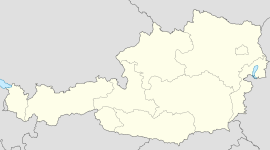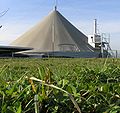- Güssing
-
Güssing Country Austria State Burgenland District Güssing Mayor Peter Vadasz Area 49.31 km2 (19 sq mi) Elevation 229 m (751 ft) Population 3,764 (1 January 2011)[1] - Density 76 /km² (198 /sq mi) Time zone CET/CEST (UTC+1/+2) Postal code 7540 Website www.guessing.co.at Güssing (Hungarian: Németújvár, Német-Újvár, Croatian: Novigrad) is a town in Burgenland, Austria. It is located at 47°4′N 16°19′E / 47.067°N 16.317°E, with a population of 3,811 (2011), and is the administrative center of the Güssing district.
The Güssing Castle, built in 1157, is the oldest castle in Burgenland and a regional landmark.
The lords of Güssing (in Hungarian: Kőszeg, in Slovak: Kysak) were a noble family in the frontier region of Austria and the Kingdom of Hungary. Note that Kőszeg is the name of a nearby Hungarian town (known as Güns in German) to which that family moved its residence from Güssing in 1274. In 1522, it became the residence of the Batthyány family, one of the most distinguished Magnate families in Hungary.
Contents
Notable people from Güssing
See also: Category:People from Güssing and Category:People from Güssing District- Batthyány-Strattmann family
- Ferenc Batthyány (Croatian: Franjo Baćan) (1497, Buda - 1566) (hu)
- Ignaz von Batthyány (1741–1798), Bishop of Transylvania (de)
- László Batthyány-Strattmann (1870, Dunakiliti - 1931), doctor and blessed of the Catholic Church
- István Beythe (1532–1612), bishop, botanist (hu)
- Ferenc Faludi (German: Franz Faludi, 1704–1779) (de)
- Samuel Steinherz, errorly "Steinberg" (1857–1942), Jewish historian born here[2]
- Josef Reichl (1860–1924)
- Jenő Nagy (1898–1944) (hu)
- Otto Kery (1923–2006), director, editor, actor (de)
- Peter Vadasz (born 1944), City Mayor
- Reinhard Koch (born 1959), together with Vadas the "creator" of energy-independent Güssing
- Josef Trinkl (1951–2004), politician (de)
- Heinz Janisch (born 1960), author (de)
- Ägidius Zsifkovics (born 1963), theologian, Bishop of Eisenstadt
- Martin Stranzl (born 1980), football player
- Michael Miksits (born 1981), football player (de)
- Peter Traxler (born ?), Kabarettist
Renewable energy
Burgenland was, some 15 years ago, the poorest and least developed region of Austria. The Güssing region was one of the poorest within Burgenland.
Güssing, a major town in south Burgenland, a district comprising around 27,000 inhabitants, is the first community in the European Union to produce its whole energy demand – electricity, heating/cooling, fuels – out of renewable resources, all resources from within the region. However, to appreciate the enormity of this achievement, you need to rewind and go back to 1988 when Güssing was one of the poorest areas in Austria. Then, the community relied on agriculture, with farmers selling corn, sunflower oil and timber to make a living. While in terms of tourism, the main/only attraction was a 12th-century castle built by Hungarian nobles. On account of the geographically unfavourable location near the border, major trade or industrial businesses did not exist at that time and the whole district did not have any transportation infrastructure at all (neither railroad nor highway). This resulted in a scarcity of jobs, 70% weekly commuters to Vienna and a high rate of migration to other regions. At the time, the town was said to be hardly able to afford its annual €6 million (£4.7million) fuel bill. To change this situation the “reformers” realised that substantial capital outflow from the region is due to the town’s energy being bought from outside sources. This included oil, power and fuels, while existing resources e.g. 45% forest land, remained largely unused. Thus the “reformers” proposed to abandon fossile energy and start producing and subsequently selling energy to the citizens (customers) themselves. So they wanted to keep that € 6 Million (value for 1992, based on conventional energy prices of that year) in the city.
In the early 1990s, a policy was proposed which called for a complete abandonment of fossil-fuel-based energy. The objective was to supply, in a first step, the town of Güssing and subsequently the whole district with regionally available renewable energy sources. The election of the town’s current mayor, Peter Vadasz, in 1992 accelerated the process, particularly when he appointed Reinhard Koch, an electrical engineer and native of Güssing, to assess how the town could benefit from its natural resources, i.e. forest land. Koch was "fresh" out of university and was not willing to share the destiny on many local commuters to Vienna. The first step taken was to order that all public buildings in the town should stop using fossil fuels.
As result of the energetic optimisation of buildings in the town, expenditure on energy was reduced by almost 50%. Then a wood burning plant that provided heating for 27 houses was built. Then, a facility was constructed which turned rapeseed into car fuel. In 1998, Koch and Vadasz saw a presentation by a Viennese scientist, Hermann Hofbauer, about a technology he had developed to make an alternative fuel from wood. They asked Hofbauer and Vienna's Technical University to build a pilot project in Güssing applying the technology, where wood chips are gasified under high temperature conditions. Gas fuels a Jenbacher engine that produces electricity and the “by-product” heat is used to produce warm water for the district heating system. Plant efficiency about 82-85%. Research and development went further on, so Güssing hosts today a number of innovative technologies, solutions, and patents. There is a team of highly trained technicians and “imported” scientists working in Güssing today.
The renewable-energy project expanded to the region and there are today 27 decentralized power plants within the Güssing county. Güssing today has an “energy” turnover of about € 14 Million p.a. Part of the profit is invested back into renewable energy projects.
What effect has this had on the area? A special scheme (very easy – stable energy prices, not linked to oil & gas, guaranteed long-term, 10–15 years) promoting the establishment of enterprises in the area has brought 50 new enterprises with more than 1,000 direct and indirect jobs in the city. (these 1000 jobs are in the City, region not calculated...). Güssing has since developed into an important location for industries with high energy consumption, such as parquetry production or hardwood drying. The real highlight is the Blue Chip Energy, first high-efficiency solar cell production in Austria, a Joint Venture with Solon AG, who came to Güssing only because they can power the plant with clean energy from the renewable resources.
The town is conscious about the resources and is keen to take care and look after the surrounding forest to ensure they have a good supply of renewable energy for the future. Added to which, the town is currently using less than half of its yearly wood growth supply to feed its power plants. Thus, no cutting the substance.
Within the process of becoming energy autonomous city, a number of proprietary technologies and patents developed, to be applied in different fields, such as photovoltaic, biomass, etc. Also, extensive experience in analysis, preparation and implementation of such projects was accumulated, that experience to be given to other cities and communities willing to go the same renewable way.
Güssing today enjoys truly international popularity. Thus, ECRE Güssing International AG was established as the central company to expose Güssing internationally (www.ecreag.com).
Significant power plants include a 2 MW electric power 4.5 MW thermic wood gas generator power plant in Güssing and, in nearby Strem, a 0.5 MW electric power 0.5 MW thermic biomass gasification power plant using green silage re-growing raw materials like grass, clover, mains, sunflower.
As side effect, extra income is being brought into the town through eco-tourism. Visitors flock from around the world to gain inspiration from the town and keen to stay true to their eco-friendly roots, guests can stay in hotels that are heated and electrically powered all by renewables. Some 30,000 visitors were recorded during 2007.
External links
- Official Website of Güssing
- Biomass gasification power plant Güssing
- Biogas plant Strem
- Official Website of the Batthyany Family
- Official Website of the Foundation of the castle of Guessing
References
- DI Dean Marcelja (ECRE AG) & Geraldine Faulkner (Sustainable Solutions), 2008
- This article incorporates information from the German Wikipedia.
Bildein · Bocksdorf · Burgauberg-Neudauberg · Eberau · Gerersdorf-Sulz · Großmürbisch · Güssing · Güttenbach · Hackerberg · Heiligenbrunn · Heugraben · Inzenhof · Kleinmürbisch · Kukmirn · Moschendorf · Neuberg im Burgenland · Neustift bei Güssing · Olbendorf · Ollersdorf im Burgenland · Rauchwart · Rohr im Burgenland · Sankt Michael im Burgenland · Stegersbach · Stinatz · Strem · Tobaj · Tschanigraben · Wörterberg
Categories:- Cities and towns in Burgenland
- Güssing
- Batthyany family
- Cities and towns in Güssing District
- Siebengemeinden
- Batthyány-Strattmann family
Wikimedia Foundation. 2010.







